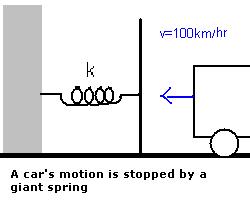Conservation of Energy
A car of mass 1200kg is moving at 100 km/hr. A large spring (spring constant k) is used to bring it to rest. If the car is designed to have a maximum acceleration of 5g, what is the maximum k that can be used?
The situation is shown in the diagrams. The car comes to rest (momentarily) after compressing the spring a distance x. Assume that some sort of locking mechanism engages there so that the car is not simply flung backwards by the uncompressing spring.
As the car comes to rest, it is going ot experience its maximum acceleration when it feels the maximum force. As the force is due to a compressed spring, the maximum acceleration happens when the car is just coming to rest - at the point of maximum compression.
To approach this problem, we will use conservation of energy to determine a relationship between the spring constant and the maximum compression and then combine that with the constraint on the maximum accelertion to finally find k.
Conservation of Energy:
KEini=KEfin
1/2mv2=1/2kx2
x=v√(m/k) (1)
a=F/m
a=-kx/m
 But, the magnitude of the acceleration is no more than 5g:
But, the magnitude of the acceleration is no more than 5g:
- |a|≤5g
|-kx/m|≤5g
kmax|x|/m=5g
- kmaxv√(m/k)/m=5g
v√(k/m)=50
√k=50√m/v
k=2500m/v2
k=3888N/m
1 comment:
thanks for suggestion. For more visit coil spring manufacturers.
Post a Comment